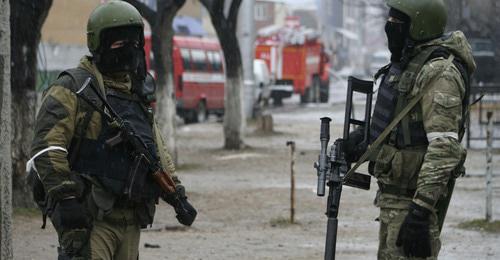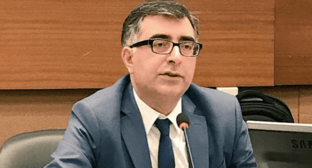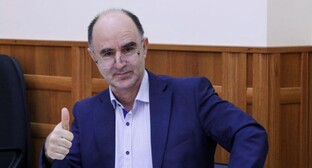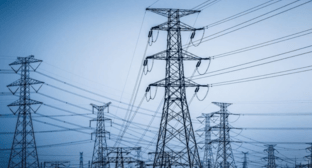
14 March 2018, 09:09
Chechnya ahead of Dagestan in ranking of unstable regions of Northern Caucasus
In 2017, most regions of the NCFD, with the exception of Dagestan and Kabardino-Balkaria, registered an increase in the number of victims to the armed conflict, especially among the civilian population. In Chechnya and Ingushetia, the number of victims among law enforcers also increased. This is especially noticeable against amid the general trend towards a decrease in the number of wounded and killed people, as indicated by the calculations run by the "Caucasian Knot" over the past eight years. The alarming statistics concerning the victims to the armed conflict in 2017 calls into question the effectiveness of an exclusively forceful fight against terrorism.
The "Caucasian Knot" published the material "In 2017, number of victims to armed conflict in Northern Caucasus decreased by 39%", posted in the Section "North Caucasus: Statistics of victims". According to the calculations run by the "Caucasian Knot" based on its own materials and information from other open sources, in 2017, in Northern Caucasus, the number of victims to the armed conflict decreased by 39% as compared to 2016, from 287 to 175 people. In 2017, the number of armed incidents in the NCFD decreased by 39%, as compared to 2016.
Future election raises doubts about Chechen "stability"
A sharp increase in the number of victims to the armed conflict amid extrajudicial executions was registered in Chechnya. For the first time since 2010, Chechnya can be called the hottest region in Northern Caucasus. In previous years, Dagestan used to be a sad leader by the number of victims.
Earlier, Chechnya was mentioned as an example by the federal centre. In 2016, Vladimir Putin twice in September, in his interview to Bloomberg and in March during a meeting with Ramzan Kadyrov praised the authorities of the republic for the fact that "Chechnya had become a safe place to live ... maybe even safer than some other points on map of Russia." However, already in April 2017, at a meeting with Ramzan Kadyrov, Vladimir Putin publicly, under the TV cameras, mentioned an attack on a base of the National Guard of Russia.
In that regard, the activities of the republic's authorities in returning family members of IS* militants from the Middle East become of particular importance and reduce the severity of the security problem in Chechnya.
There is no official summary statistics in the open sources on the number of people who returned from Syria. In their reports, officials voice the growing figures, but it is not possible to check them. On November 13, Chechen leader Ramzan Kadyrov announced that the republic's authorities "had returned 89 people to their families."
A month later, Ziyad Sabsabi, a representative of Chechnya in the Federation Council, reported on the return of 93 children and women. However, from November 13 to December 13, no information was reported that more women and children were brought from Syria or Iraq to Russia. It was unknown who those four people, and their fates were also unknown.
The summary, announced by Ramzan Kadyrov on November 13, was also not supported by the information from open sources, which reported that not 89, but 87 people were returned. The fate of two remained unknown.
The Chechen authorities used the process of returning women and children from the Middle East for propaganda purposes: under TV cameras, grateful relatives met their rescued daughters and grandchildren who came out of airplanes with posters in their hands reading: "Thank you, Russia." Later, they also reported that they were living an ordinary life in Chechnya. The situation in the republic presented in such a way looked favourably against the background of the attitude towards returnees in Ingushetia and Dagestan, where former IS* residents were necessarily subjected to criminal prosecution. After their return, some of the women were detained in Dagestan.
Meanwhile, the Russian special services, which earlier quietly watched the return of women from Syria, suddenly decided to stop the return process, reported sources of the "Dozhd" (Rain) TV channel, close to the Chechen authorities. The report from Northern Caucasus, posted on the website of the "Dozhd" TV Channel on March 7, stated that Dagestan and Chechnya had completely different attitudes to the people who had returned from the "Islamic State"*.
"The above already leads to tension between Dagestan and Chechnya. In Grozny, the authorities believe they are doing a good deed, and Makhachkala officials answer that they have not even consulted with the authorities of Dagestan whether they should return their citizens home and what should be done with them," states the report describing the fate of the three women of Northern Caucasus who returned from ISIS*.
On the eve of the presidential election in Russia, the largest number of victims to the armed conflict in NCFD raises doubts about Chechen "stability" and the need to maintain the Ramzan Kadyrov's special status in relations with the Kremlin.
Chechnya: number of victims to armed conflict increases amid extrajudicial executions
After the counterterrorist operation (CTO) legal regime valid in Chechnya since 1999 was lifted in 2009, the republic generally tended to a decrease in the number of victims to the armed conflict.
So, in 2013, at least 101 people fell victim to the armed conflict in Chechnya. Of them, at least 39 were killed and 62 others were wounded. In 2012, 174 people fell victim to the armed conflict (82 killed and 92 wounded), in 2011, at least 201 people fell victim to the armed conflict (95 killed and 106 wounded), while in 2010 250 people (127 killed and 123 wounded).
However, following the results of 2014, with the general trend to reduction in the number of victims to the armed conflict in Northern Caucasus, Chechnya became the only region of the NCFD, where directly opposite tendencies were registered. Then, the experts noticed that it was from 2014 when the Chechen authorities began to seek legalization for methods of collective punishment in the republic.
In particular, the above is stated in the report prepared by the International Crisis Group and entitled "Chechnya: the Inner Abroad", which was published in the Section "Reports" on the "Caucasian Knot". Authors of the report predicted that the leader of Chechnya "might face serious problems from militants and ordinary citizens dissatisfied with his ruling."
In 2015, in Chechnya, the total number of victims to the armed conflict decreased, although the number of victims among civilians increased as compared to 2014. In 2016, compared with 2015, the number of victims in Chechnya increased by 43%.
In 2017, the tendency towards an increase in the number of victims strengthened: in comparison with the previous year, the total number of victims increased by more than 74%. The region was also marked for the growth in the number of armed incidents: their number increased by 33% as compared to 2016, and the number of victims to them by 29%.
The provided statistics cannot reflect with the 100 percent accuracy the number of victims for each of the categories highlighted in the review. Not all information is included in the news reports. It is not always possible to check the reliability of the statements voiced by the law enforcement bodies and to reveal involvement of members of the armed underground in certain crimes. Meanwhile, the number of killed and wounded militants and civilians, calculated according to the data of the "Caucasian Knot", is given without taking into account the information about residents of the region kidnapped in fabricated criminal cases.
It should be noted that in Chechnya, the number of victims to the armed conflict has significantly increased because of extrajudicial executions and repressive actions of the authorities. So, the number of victims includes 25 killed civilians, about whom the newspaper "Novaya Gazeta" reported on July 9, 2017. According to the edition, at least 27 people were executed, detained in the republic at night on January 26, 2017, in connection with an attack on policemen in Grozny in December 2016. The authorities of the republic called the information a lie.
On the basis of the calculations run by the "Caucasian Knot", it is possible to trace another tendency: an increase in the number of victims among civilians in the NCFD. In 2017, 30 civilians were killed and nine others were wounded. The total number of victims among civilians is almost 63% higher than in 2016, when 24 civilians fell victim, including eight killed and 16 wounded.
Thus, in 2017, against the background of the legalization for methods of collective punishment in the republic, Chechnya became the most unstable region of Northern Caucasus. If the trend for extrajudicial executions and repressive actions is maintained, the republic will risk remaining a leader in the ranking of unstable regions in Northern Caucasus in 2018.
Dagestan: a significant decrease in number of victims
In 2017, in Dagestan, at least 55 people fell victim to the armed conflict. In 2017, as compared to 2016, the total number of victims to the conflict decreased by 73%. For comparison, in 2016, a sharp increase in the number of armed incidents (by 12%) and explosions (by 225%) was registered in Dagestan.
According to the calculations run by the "Caucasian Knot", it was Dagestan which for the past seven years kept the first place by the number of victims to the armed conflict in Northern Caucasus. In 2009, Ingushetia was the leader by the number of victims of the conflict, in which then large-scale terror acts led to a sharp increase in the number of victims.
The authorities of Dagestan experimented with the strategy of "soft power": Magomedsalam Magomedov, one of the former leaders of the region, created a commission on adaptation of militants in November 2010. However, already in February 2013, Ramazan Abdulatipov, who replaced him, said that the role of the commission on adaptation of militants was insignificant and that another body was to be created in the republic to deal with the prevention of extremism.
In 2009-2012, the strategy of "soft power" in Dagestan implied a dialogue with different sectors of society, interaction with rights defenders, return to peaceful life of militants ready to lay down arms, and facilitation of a dialogue between followers of different concepts in Islam.
When Ramazan Abdulatipov came to power, Dagestan experienced a gradual return to the methods of "state terror." Such a conclusion is illustrated by the graphics "Armed incidents and victims in Northern Caucasus" prepared by the "Caucasian Knot", which compiled a summary of the number of incidents and victims over the past four years. The consequences of the abandonment of the "soft power" methods in Dagestan are clearly traced both by separate annual data sets and the entire 2014-2017 period presented in the graphics.
In 2017, as compared to 2016, the number of victims in Northern Caucasus decreased by 112 people, from 287 to 175. Meanwhile, in 2017, as compared to 2016, in Dagestan, the number of victims to the armed conflict had decreased by 149 people, from 204 to 55. In Kabardino-Balkaria, the number of victims to the armed conflict decreased by 14 people from 15 victims in 2016 to one victim in 2017.
It can be concluded that the decrease in the number of victims to the armed conflict in general in Northern Caucasus is connected precisely with the improvement of the situation in Dagestan and Kabardino-Balkaria. The republics still retain a tendency to reduce both the number of victims and armed incidents.
Situation gets worse in Ingushetia and North Ossetia
Apart from Chechnya, the tendency an increase in tension is noted in Ingushetia and North Ossetia, Karachay-Cherkessia, and the Stavropol Territory.
In 2017, in Ingushetia, at least 24 people fell victim to the armed conflict, and the total number of victims increased by 26%. Statistics for 2017 suggests a destabilization of the situation in Ingushetia, since earlier, the region had a consistent annual decline in the number of victims since 2013 years and up to 2016.
In 2017, in North Ossetia, nine people fell victim to the armed conflict. In 2016 and 2015, no victims to the armed conflict were registered in the republic, and no increase in the number of victims has been reported for the past seven years. Thus, victims to the armed conflict were reported in the region after two calm years.
Stavropol Territory: for the first time since 2010, militants become more active in Stavropol
In the period from 2010 to 2016 inclusively, 92 people were killed in the armed conflict in the Stavropol Territory, reports the interactive circular diagram, which presents the calculations of the "Caucasian Knot", based on its own materials and information from other open sources.
In 2017, at least six people were killed in the armed confrontation in the Stavropol Territory. The number of victims was the same as in 2016. However, it should be noted that in 2017, two special operations were conducted in Stavropol. Meanwhile, militants did not attack the regional centre since 2010, when a terror act was committed in front of the palace of culture. Since 2010, armed incidents occurred mostly in settlements located on the borders between the Stavropol Territory and Karachay-Cherkessia, Kabardino-Balkaria, Dagestan, and Chechnya. CTO legal regimes were also introduced in Pyatigorsk and Mineralnye Vody.
Karachay-Cherkessia: republic ceases to be the most peaceful region
Earlier, Karachay-Cherkessia was considered one of the most peaceful regions among the republics of Northern Caucasus. In part, that was true and was confirmed, in particular, by the statistical calculations about the situation in the region, and journalists and rights defenders saw signs of falsification of charges in criminal trials on "terror articles."
In 2016, no victims to the armed conflict were registered in the republic. In 2017, five people fell victim to the armed conflict in Karachay-Cherkessia. All of them were killed in the same armed incident which occurred in December 2017 in a summer village on the outskirts of the Zelenchukskaya village. According to the law enforcement bodies, the killed suspected were plotting terror acts to be committed to crowded places.
The special operations in Stavropol and an armed clash in Karachay-Cherkessia are interconnected and prove the growing strength of militants, suggest journalists working in the Stavropol Territory.
Thus, the data on Karachay-Cherkessia indicate a tense situation in the republic. Meanwhile, the law enforcement bodies regularly report on the discovery of armed groupings in the KChR, which are carrying out plans to seize power.
According to the calculations run by the "Caucasian Knot", over the past 10 years, at least 70 people were sentenced under the charges with trying to seize power in Karachay-Cherkessia. Defendants often claimed that the criminal cases had been fabricated.
So, already in 2018, the North-Caucasian District Military Court pronounced a sentence in the case on creating a cell of the terrorist organization "Islamic State"* in Karachay-Cherkessia. The prisoners' dock contained Alexander Bendenko, Amic Sapigulaev, Batz Khabibov, Rasul Saipudinov, Lilit Khozieva, and Muzakir Paunezhev. The defendants were charged with organizing and participating in an IAF and trafficking in firearms committed by a group of persons in a preliminary conspiracy. The defendants complained to the court about torture during the investigation and fabrication of the criminal case, but the court sentenced them to 8.5-17 years of imprisonment.
In June 2017, in Cherkessk, a court sentenced to long term of imprisonment six residents of the republic on the charge of creating an armed grouping. During the investigation, searches were conducted in the houses of those people, during which ammunition, explosives, explosive devices, several sets of camouflage clothing, as well as a flag with the symbols of the terrorist organization "Islamic State"* organization banned in Russia by the court were seized. The defendants pleaded not guilty and challenged the verdict, but the Supreme Court (SC) of Karachay-Cherkessia upheld the decision.
The alarming signs of more active armed underground in formerly calm regions spoil the overall good picture of the decline in the number of victims, military incidents and terror acts. The intensity of the opposition decreases as a whole, but the opposition itself becomes wider and captures new territories.
Kabardino-Balkaria: region becomes the safest in NCFD
Based on the number of victims to the armed conflict in 2017, Kabardino-Balkaria was the safest region of the NCFD. In 2017, only one victim to the armed conflict was registered in the republic: a suspected militant was killed. In 2016, at least 15 people fell victim to the conflict.
The number of armed incidents and the total number of victims to the armed conflict has been decreasing in the republic for several years in a row, starting from 2011, when 129 people were killed and other 44 were injured in the republic.
A special feature was the fact that for almost a year, from January 1, 2017 to December 15, 2017, no armed incidents and, accordingly, no victims were reported in the republic at all. Besides, no bombings were registered, whereas in 2016, there was the first such incident in two years.
In 2017, Kabardino-Balkaria became the safest region in the NCFD. That is clearly shown by the infographics "Statistics of victims in Northern Caucasus in 2017 according to the 'Caucasian Knot' data".
The trend towards a steady decline in the number of victims to the armed conflict, which was so clear in Kabardino-Balkaria, is somewhat spoiled by the growth in the number of victims to the confrontation in a number of other regions in Northern Caucasus. The successes of law enforcers in Kabardino-Balkaria (obvious in themselves) can also be explained by the fact that militants themselves do not lay down their arms, but transfer their activities to other territories.
No mass return of militants from Syria registered
Meanwhile, the calculations run by the "Caucasian Knot" indicate that every year, the number of armed incidents in Northern Caucasus is steadily decreasing.
The "armed incidents" category includes: shootouts, shelling, i.e., any event involving the presence of two parties (militants, law enforcers) at the same time.
In 2017, as compared to 2016, the number of victims to the armed conflict decreased by 39%, from 287 to 175 people. In 2017, for the first time during the monitoring, less than 200 people fell victim to the conflict.
A sharp decline in the number of incidents occurred in 2015. In 2017, the trend reappeared, and that can be explained by the outflow of militants to Syria in 2013-2014.
However, after the reduction of the territory controlled by the IS* in Syria and Iraq, no mass return home of natives of Northern Caucasus who fought on the side of the militants has been observed so far. The authorities have never reported about killing in an armed clash or a special operation of a militant who fought in Syria, although occasionally there are reports of people being detained on suspicion that they used to fight in Syria on the side of the Bashar al-Assad's opponents.
Fears of a possible escalation of the conflict in Northern Caucasus connected with the defeat of the IS* in Syria and Iraq and the return of militants to the Caucasus have not yet come true. However, that can be explained not only by the efficient activities of the law enforcement bodies, who prevent participants of the conflict in the Middle East from returning to their homeland, or by the heavy losses among militants directly in Syria and Iraq. It can be assumed that some of the militants move from the defeated IS units to other jihadist groupings, as well as by their departure to other countries. If the latter is reasonable, then in the coming year we will see a "Caucasian trace" in reports of armed incidents and terror acts in other countries.
Law enforcers: leaders of Dagestani grouping eliminated
The decrease in the number of armed incidents can also be explained by the fact that in 2017, according to reports of the law enforcement bodies, the leaders of the Makhachkala, Gubden, Kadar, Malgobek, Khasavyurt, and Khunzakh groupings were killed.
Meanwhile, it cannot be said that all the "leaders" actually occupied high positions in the militant hierarchy. The websites affiliated with the armed underground in Northern Caucasus did not confirm the reports of the law enforcement bodies, although earlier, they had regularly reported on the "shahadah" of their leaders.
In 2016, the law enforcement bodies reported about 17 militant leaders killed in the republic.
On December 19, 2017, Ilyas Sharipov was killed. He was on the federal wanted list and was a brother of suicide bomber Maryam Sharipova, who blew herself up in the Moscow metro in 2010. The law enforcement bodies declared him the "leader" of the "Balakhninskaya" grouping. It should be noted that in 2010, Ilyas Sharipov addressed with an open letter to the leader of Dagestan with a request to protect him from persecution initiated by law enforcement officials.
Killings of leaders of sabotage and terrorist groupings with maintenance of a potential militant recruitment base resulted in a decrease in the number of attacks requiring group training and coordination among militants.
As follows from the chronicle of terror acts committed by suicide bombers in Russia kept by the "Caucasian Knot", in 2017, the only suicide bombing was a self-bombing at a road-and-patrol service (known as DPS) checkpoint located near the village of Yandare in Ingushetia. The rest of the militants entered an armed clash with law enforcers. Two policemen died from injuries got in the explosion. The National Antiterrorist Committee (NAC) reported about two militants killed in the armed clash.
IS* militants refuse complex attacks
In August 2016, the grouping "Islamic State" recognized as a terrorist organization and banned in Russia by the court disseminated a video calling for jihad in Russia. After that, the "Islamic State" began to increasingly often claim attacks in Northern Caucasus.
Meanwhile, the number of actions for which the IS* claimed responsibility slightly decreased in Northern Caucasus, but increased in Russia as a whole. Thus, in 2016, the IS* claimed responsibility for attacks on law enforcers in Northern Caucasus at least six times, including five times in Dagestan in 2016 and one time in Chechnya.
In 2017, the IS* claimed responsibility for five attacks in Northern Caucasus and four attacks in other regions of Russia. In particular, the IS* claimed responsibility for two attacks in April 2017 in Astrakhan, an attack in Surgut in August 2017, at attack in Kotelnikovo in November and an attack in Saint Petersburg in December 2017.
It should be noted that in Astrakhan, attackers shelled policemen, in Saint Petersburg, there was a bombing in a supermarket, while in Surgut and Kotelnikovo, attackers used cold weapons. If the incidents in Saint Petersburg and Astrakhan can be attributed to the "classic" terror acts, then the attacks in Surgut and Kotelnikovo can be attributed to the "inspiration attacks" committed by people provoked by propaganda of the IS*.
Judging by the attacks committed by militants in 2017, it can be concluded that militants of the "Islamic State"* retract difficultly organized group attacks and commit solo actions requiring minimal organization and funds.
In 2017, in his material "Sokolov: in Surgut, IS* wins a war for the minds of Muslims", Denis Sokolov, the head of the RAMCOM Centre for Socio-Economic Research of the Regions, noted that Russian realities provided a favourable environment for ideologists of the IS*.
Reduction in complexity and "terror adaptability" of attacks leads to a decrease in the number of their victims, but makes it extremely difficult to prevent them. Law enforcers have much less opportunity to prevent an attack of a loner who listened to propaganda than to prevent preparation of terrorists at the stage of plotting a terror act. Resonant attack on believers in Kizlyar, which occurred already this year, confirms the thesis.
2017 marked by failures in National Guard of Russia's activities
The Federal Service of the National Guard (National Guard of Russia), directly subordinate to the President of Russia, is a law enforcement body which has been acting in Russia for the second year. On April 5, 2016, the National Guard of Russia was created by Vladimir Putin on the basis of the internal troops of the Ministry of Internal Affairs (MIA), and Viktor Zolotov was appointed the head.
Meanwhile, the years of 2017 was marked by failures in the activities of the National Guard of Russia and attacks by militants against its fighters. In Chechnya, in two attacks committed in January and March, eight fighters of the National Guard of Russia were killed and three others were injured. In April, in Astrakhan, three fighters were injured in shelling.
The above did not prevent the expansion of the powers of Viktor Zolotov, who on July 29, 2017, was instructed by the Russian President to lead the antiterrorist group in Northern Caucasus. The National Guard of Russia possesses the broadest powers among the law enforcement bodies, and Viktor Zolotov was given the opportunity to recruit staff members of other law enforcement bodies, Ministry for Emergencies (MfE) and military personnel to participate in counterterrorist operations (CTOs).
Despite that, there were still incidents involving fighters of the National Guard of Russia. Last year, it became known about fights and beatings of commanders of the units, the incident when a fighter from the National Guard of Russia opened fire on his colleagues, and the incident when an officer was killed in a shootout in a cafe.
It can be concluded that the new leader, who does not have much experience in military leading, failed to change the situation. There was no improvement with regard to incidents among law enforcers themselves or in the armed confrontation with militants. There is no reason to believe that the trend of 2017 to an increase in the number of incidents with the participation of fighters from the National Guard of Russia, as well as the loss of law enforcers in conflicts and clashes with each other, will change in the current year of 2018.
* organization in recognized as terrorist in Russia and banned by the court




